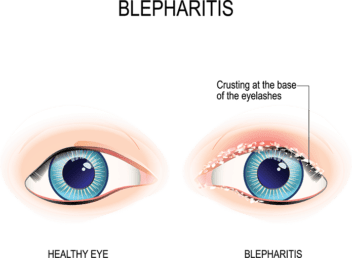Last Updated
Further Reading
- Types of Lenses For Cataract Surgery
- Headache Caused By Eye Strain?
- Eye Refraction
- Can Dilated Pupils Be Dangerous?
- Remedies for Eye Bags
- Pearle Vision vs. LensCrafters
- Color Blindness Causes
- Stress & Vision
- 20/30 Vision
- 20/40 Vision
- Eczema Around the Eyes
- Vision Issues in Pregnancy
- Lupus and Eyes
- Salaries for Optometrists
- Am I a Candidate for LASIK? Take our LASIK Candidate Quiz To Find Out!
- When to Get Cataract Surgery
- How Long Does LASIK Take?
- The Different Types of Eye Doctor
- Learn & Compare Different Types of Vision Correction Procedures
- Different Types of Eye Care Professionals
- Becoming an Ophthalmologist:
- How Often Should You Get Your Eyes Checked?
- Microblading
- Is Eyebrow Tinting Safe?
- Crow's Feet
- Current State of US Eye Health
- How Do Blind People Experience Their Dreams?
- Childhood Bullying
- Eye Care Guide for Seniors
- Mental Health Effects of Vision Issues
- Vision Care Guide for Veterans
- VR & Your Eyes
- Career Options for the Visually Impaired
- Anatomy of the Eye
- Eye Damage From the Sun
- Guide to Bionic Eyes
- How to Test for Your Dominant Eye
- Eye Damage From Solar Eclipses
- Young Adults & Vision Loss
- Optic Nerve Cupping
- Light Sensitivity
- What Is Night Blindness?
- How Eye Patches Affect Your Good Eye
- Blindness From Staring at the Sun
- Types of Vision Tests
- Botox Around the Eyes
- Optometrists vs. Ophthalmologists
- Vision Loss & Driving
- Visual Disturbances
- Pros & Cons of Eye Colors
- Driving With Visual Impairments
- Screen Time & Eyes
- Facts, Stats & Myths - Blue Light
- Jaundice of the Eyes
- Eczema on the Eyelids
- Drugs That Cause Dilated Pupils
- Cholesterol & Your Eyes
- Tea Bags for Eyes
- Eye Disease Statistics
- Brown Eyes vs. Hazel Eyes
- Aqueous & Vitreous Humor
- Prosthetic Eyes
- Guide to Enucleation
- Contrast Sensitivity Testing
What You Should Know About LATISSE (Side Effects & More)
Home / Vision Education /
Last Updated
Table of Contents
LATISSE helps to grow eyelashes. It is mainly a cosmetic medication, but it does require a prescription.
While the substance works well for many people, it may not work for every condition that leads to thin or lost eyelashes, and it appears to work better for some people than others.
There are also LATISSE side effects and risks, from darkening of the eyelids and irises to lowering intraocular pressure and exacerbating irritation.

What Is LATISSE, and Does It Require a Prescription?
LATISSE is a medical treatment approved by the U.S. Food and Drug Administration (FDA) to treat hypotrichosis of the upper eyelashes. The active ingredient in LATISSE is a prostaglandin analogue, which helps to stimulate the follicles, so hair grows faster.
The main reason for LATISSE treatment is to address people who have shorter eyelashes and want longer ones. This condition may have a genetic component, but it is not a life-limiting medical condition, except where it causes insecurity or shame.
Many people have benefited from LATISSE treatments, which are easy to acquire after a quick consultation for a prescription. This prescription is required, as there are some complications that the individual must be informed of, and they should have an overseeing doctor who can manage LATISSE side effects.
LATISSE Works Well for Many People, but Not Everyone

The active ingredient in LATISSE was originally used in a prescription medication called LUMIGEN, which treats high intraocular pressure (IOP), a potential sign of glaucoma. It can cause nerve damage in the eye, leading to vision loss.
A side effect of LUMIGEN was eyelash growth, which led to the development of the eyelash-growing serum. No one is completely sure how LATISSE stimulates hair growth, but it has worked for thousands of people all over the United States who want fuller, longer, darker eyelashes.
Common causes for eyelashes to fall out or become thinner include:
- Irritation from cosmetics.
- Blepharitis, or eyelid irritation from clogged oil glands in the eyelash area.
- Trichotillomania, or an anxiety disorder that leads to pulling out hair, including eyelashes.
- Localized skin cancer, leading to hair loss.
- Alopecia areata.
If you suddenly lose your eyelashes, you may have an underlying medical condition that requires different treatment. LATISSE alone cannot solve this problem.
LATISSE specifically treats hypotrichosis, or thin or too-short hair, in the upper eyelash area. The medication is approved after an initial consultation for people who are 18 and older. It is not recommended by the FDA to anyone younger than 16 years old.
The medication is applied to the lash line of the upper eyelid once per day, using a disposable, sterile applicator.
People who benefit from LATISSE may include:
- Those with genetic causes of thinner or paler lashes.
- People with medical conditions that affect the eyes, eyelids, and eyelashes, leading to hair loss.
- People who have lost their hair due to an injury.
- Those who lost their hair due to radiation or chemotherapy during cancer treatment.
Although LATISSE requires a prescription, it is important to know that the serum does not start working immediately. It requires regular application for months to make hair follicles grow eyelashes longer and darker than before.
It is unlikely that your health or vision insurance will cover a LATISSE prescription since it does not treat serious eye conditions. Instead, you will pay each month out of pocket for LATISSE while you wait for results to show. In order to maintain lash growth, you must keep using it regularly.
There is one condition that may receive coverage from your health insurance: alopecia areata, which causes hair all over the body to fall out in round patches. The condition may impact the eyelids, although this is rare. When it does, eyelashes will fall out. LATISSE may be approved as an approach to treating this condition, although scientific studies on the serum’s efficacy were mixed.
LATISSE Side Effects and Risks

There are some warnings and risks associated with using LATISSE. Even though it is easy to get after a consultation with a medical professional, and it is not tightly regulated by the FDA or the Drug Enforcement Administration (DEA), there are still some medication and illness reactions, along with potential LATISSE side effects, to be aware of.
- Mixing LATISSE with a similar medication called LUMIGAN can cause unintended side effects. The active ingredient in both medications is bimatoprost ophthalmic solution, which can lower intraocular pressure (IOP). In people with early stages of glaucoma or other conditions that raise fluid pressure inside the eyes, LUMIGAN eye drops may relieve some of this pressure; however, using LATISSE at the same time can cause a reaction between the medications, as they have the same active ingredient.
- Reducing IOP can also mask glaucoma, which may damage nerves without very high eye pressure.
- Intraocular inflammation can also be a side effect of LATISSE use if you already have inflammation in that area, such as from uveitis.
- Eye irritation or dry eyes may be a side effect from regular LATISSE use, which could lead to other visual complications.
- Macular edema, or a buildup of fluid in the macula (the center of the retina), has been a reported side effect of LUMIGAN treatment for high intraocular pressure. There is a small risk of macular edema associated with LATISSE because the medication can change fluid pressure in the eye. It is important to get regular eye exams to understand your overall eye health and how medications like LATISSE can impact your vision by changing pressure, fluid amounts, or other parts of your eye.
- Changes to iris pigmentation have occurred in people who use LATISSE for a long time. The iris is the part of the eye that determines eye color. In people who have lighter eyes like blue or green, LATISSE may add brown spots that are permanent. This is caused by increased melanin content in the melanocytes, so eye color is truly changed at the chemical level; however, iris pigmentation changes are more likely to occur after several months or years of regular treatment.
- LATISSE may also lead to pigmentation changes on the eyelids due to changes in melanin in the skin. Bimatoprost can darken the preorbital area, which is expected to increase with more applications of LATISSE. Unlike iris pigmentation, skin pigmentation from LATISSE typically goes away once treatment stops.
- Applying LATISSE outside the thin upper eyelash line can cause more hair growth in that area, so be careful to apply the medication only to the recommended area of skin.
- Using LATISSE with contact lenses can be risky. The medication contains benzalkonium chloride, which can be absorbed by soft contact lenses, so it is important to take contact lenses out of the eyes before applying LATISSE and then wait 15 minutes before putting them back in.
- LATISSE has not been clinically tested on pregnant women, so it should not be used during pregnancy.
Most people can safely use LATISSE and benefit from feeling more confident in their appearance. If you have any concerns, speak to your eye doctor before starting LATISSE.
References
- Highlights of Prescribing Information: LATISSE. (March 2012). U.S. Food and Drug Administration (FDA).
- Eyelash Lengthening Consultation. Minute Clinic, CVS Pharmacy.
- What You Should Know About LATISSE. (July 19, 2011). American Academy of Ophthalmology (AAO).
- Why Are My Eyelashes Falling Out? (February 12, 2019). American Academy of Ophthalmology (AAO).
- The Real Risk of Having Longer Lashes. (February 2010). Consumer Reports.
- Six Things You Need to Know Before Trying LATISSE. (September 21, 2016). Women’s Health Magazine.
- Alopecia Areata. American Academy of Dermatology.
- Is there a Medication to Thicken Eyelashes? (April 5, 2018). Mayo Clinic.
The information provided on this page should not be used in place of information provided by a doctor or specialist. To learn more, read our Privacy Policy and Editorial Policy pages.
Further Reading
- Types of Lenses For Cataract Surgery
- Headache Caused By Eye Strain?
- Eye Refraction
- Can Dilated Pupils Be Dangerous?
- Remedies for Eye Bags
- Pearle Vision vs. LensCrafters
- Color Blindness Causes
- Stress & Vision
- 20/30 Vision
- 20/40 Vision
- Eczema Around the Eyes
- Vision Issues in Pregnancy
- Lupus and Eyes
- Salaries for Optometrists
- Am I a Candidate for LASIK? Take our LASIK Candidate Quiz To Find Out!
- When to Get Cataract Surgery
- How Long Does LASIK Take?
- The Different Types of Eye Doctor
- Learn & Compare Different Types of Vision Correction Procedures
- Different Types of Eye Care Professionals
- Becoming an Ophthalmologist:
- How Often Should You Get Your Eyes Checked?
- Microblading
- Is Eyebrow Tinting Safe?
- Crow's Feet
- Current State of US Eye Health
- How Do Blind People Experience Their Dreams?
- Childhood Bullying
- Eye Care Guide for Seniors
- Mental Health Effects of Vision Issues
- Vision Care Guide for Veterans
- VR & Your Eyes
- Career Options for the Visually Impaired
- Anatomy of the Eye
- Eye Damage From the Sun
- Guide to Bionic Eyes
- How to Test for Your Dominant Eye
- Eye Damage From Solar Eclipses
- Young Adults & Vision Loss
- Optic Nerve Cupping
- Light Sensitivity
- What Is Night Blindness?
- How Eye Patches Affect Your Good Eye
- Blindness From Staring at the Sun
- Types of Vision Tests
- Botox Around the Eyes
- Optometrists vs. Ophthalmologists
- Vision Loss & Driving
- Visual Disturbances
- Pros & Cons of Eye Colors
- Driving With Visual Impairments
- Screen Time & Eyes
- Facts, Stats & Myths - Blue Light
- Jaundice of the Eyes
- Eczema on the Eyelids
- Drugs That Cause Dilated Pupils
- Cholesterol & Your Eyes
- Tea Bags for Eyes
- Eye Disease Statistics
- Brown Eyes vs. Hazel Eyes
- Aqueous & Vitreous Humor
- Prosthetic Eyes
- Guide to Enucleation
- Contrast Sensitivity Testing